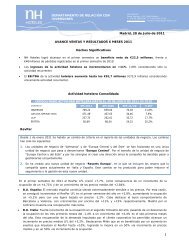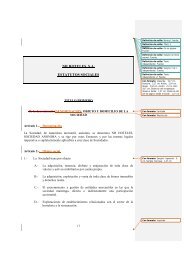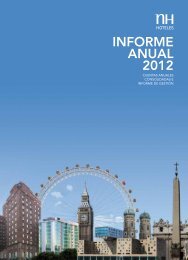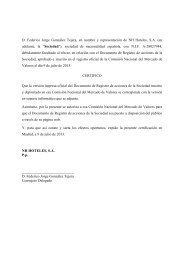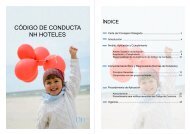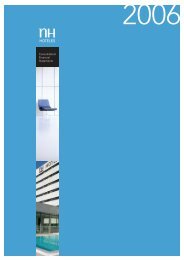Download Complete PDF - Informe Anual 2012
Download Complete PDF - Informe Anual 2012
Download Complete PDF - Informe Anual 2012
You also want an ePaper? Increase the reach of your titles
YUMPU automatically turns print PDFs into web optimized ePapers that Google loves.
In order to ensure the reliability of the Financial Information, accounting errors that may arise from the following control objectives are always borne<br />
in mind:<br />
• <strong>Complete</strong>ness: balances or transactions that should be recorded but are not.<br />
• Transaction cut-off: those booked in a period other than when they were accrued.<br />
• Accuracy: transactions recorded with errors (amounts, conditions).<br />
• Occurrence/ Existence: transactions that have taken place within the period.<br />
• Valuation/Allocation: record of transactions involving incorrect sums due to inadequate valuation calculations.<br />
• Presentation/ Classification: classification errors in the various entries of the financial statements.<br />
The controls and procedures defined within the Internal Financial Information Control System support the relevant processes to ensure the proper<br />
functioning of the information systems, such as secure access, monitoring of changes in the systems, operational continuity and separation of functions.<br />
Supervision of the management of activities outsourced to third parties, as well as any possibly relevant evaluation, calculation or valuation tasks<br />
commissioned from independent experts are also covered by this control structure.<br />
Every month, the Group Finance Department submits the management report to the Board of Directors for their consideration. The report includes<br />
the most important financial and managerial information, the profit and loss account, and the key indicators and financial ratios. A statement of<br />
financial position is also submitted quarterly.<br />
The Board of Directors periodically requests an analysis of specific issues, as well as the details of particular financial transactions that, because of their<br />
importance, need to be studied in greater depth.<br />
The Chairman of the Audit and Control Committee periodically reviews this financial information during its meetings and, as required, requests the<br />
attendance of either external and/ or internal auditors.<br />
4. Information and Communication<br />
The company’s Resources Department is responsible for the unification, analysis and publication of all its internal rules and procedures, most notably<br />
the operational, administrative (including accounting), quality and regulatory procedures. It is the responsibility of each area (finance, operations,<br />
purchasing, sales, etc.) to issue and maintain the rules relevant to their area and that form an integral part of the company’s internal controls.<br />
Although the accounting criteria are the responsibility of the Resources Department, the Finance Department is responsible for defining and applying<br />
these criteria and ensuring that they are up to date and approved.<br />
To that end, the Company currently has a common Accounting Plan, a Manual of Accounting Rules and a Consolidation Manual, applicable to all the<br />
countries in which the Group operates, which are updated at least annually. The aforesaid regulatory compendium reflects the requirements of the<br />
International Financial Reporting Standards (IFRS), which are the accounting standards by which the Group is governed.<br />
Interpretation and application of the financial reporting regulations is the responsibility of the Group Financial Department, which updates and checks<br />
any possible new regulatory developments relating to the generation of financial information twice a year.<br />
5. Supervision of the system<br />
The Audit and Control Committee is responsible for supervising internal control, which it does by means of the Internal Audit Department, which<br />
attends the sessions of the Audit and Control Committee whenever the committee feels this to be necessary.<br />
The Audit and Control Committee regularly carries out the following supervisory and control functions, as specified in Article 25 b) of the Regulation<br />
of the Board of Directors:<br />
- Supervision of internal control and risk management, evaluating and supervising the effectiveness of the internal control and risk management<br />
systems, including those affecting the reliability of financial reporting.<br />
- Supervision of regulated financial information, analysing the process whereby the regulated financial information is produced and presented.<br />
- Supervision of audit activities.<br />
This means that, with regard to the foregoing, the Groups’ Financial Information Control System makes it possible to:<br />
- Provide management and the Board of Directors with sufficient information to determine whether the internal financial information control system<br />
is functioning correctly.<br />
- Identify and correctly control defects before they can have any significant impact on the quality of the financial information.<br />
- Maintain proper control operations, aimed at prioritising risks and maintaining constant supervision by identifying the controls for the most<br />
significant risks, identifying key controls, and lastly, checking that these controls are sufficient.<br />
Risks of this kind are assessed by the Internal Audit Department continuously throughout the financial year. The actions carried out by that department<br />
are defined in its annual plan, which includes checking and assessing the operational controls in place in the key business processes, especially those<br />
related to the hotel business.<br />
This supervision of the Internal Financial Information Control System ends with the most significant results and shortfalls being reported to those in<br />
charge, their managers and the Audit and Control Committee, and remedies are proposed in an action plan.<br />
In the process of reviewing and reporting the results, the internal audit team meets with the centre managers at the end of each review and quarterly<br />
with the directors of the business units. At those meetings, incidents are examined and future action plans are defined.<br />
The Audit Plan is approved annually by the Audit and Control Committee, and applies to all the Group business units.<br />
The Internal Audit team has a presence in the Group’s main business units, some of the most significant of which are Spain, Germany, Benelux and<br />
Italy, and its ongoing work helps to guarantee the effectiveness of the oversight tasks needed to ensure proper application of the Company’s internal<br />
control system.<br />
ANNUAL CORPORATE GOVERNANCE REPORT 61



